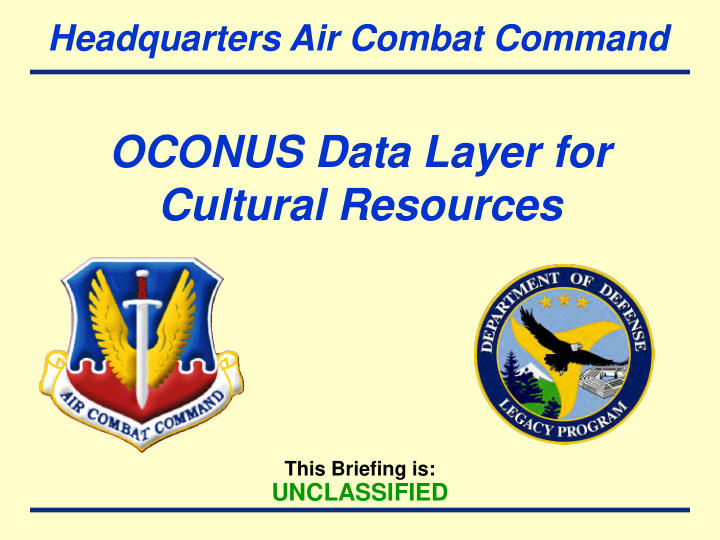



Headquarters Air Combat Command OCONUS Data Layer for Cultural Resources This Briefing is: UNCLASSIFIED
DoD Legacy Resource Management Program PROJECT NUMBER 05-266 A Feasibility Study to Develop an OCONUS Data Layer for Cultural Resources Carla R. Van West, Ph.D., SRI Foundation, Rio Rancho, NM Clay Mathers, Ph.D., Statistical Research, Inc., Albuquerque, NM February 2007
OCONUS Data Layer for Cultural Resources • Problem • Feasibility Study to Develop an OCONUS Data Layer for Cultural Resources • Sample OCONUS Regions and Resources • Literature Review: DoD and USAF • Methods: Data Acquisition, Storage, Display • Results: Central America and Balkans • Recommendations
Problem • No comprehensive and validated data layers for OCONUS cultural resources currently exist • DoD units working in OCONUS contexts need information to avoid or reduce negative impacts to sensitive cultural resources • Geospatial data on cultural resource locations can be retrieved and viewed during planning for: • Deployments • Beddown operations • Training Events • Contingencies • Nation-Building Efforts • Military Operations Other Than War
Feasibility Study to Develop a Cultural Resource Layer GOALS: • Develop and partially populate a database and a GIS data layer for OCONUS regions where DoD personnel are deployed • Assess the depth, breadth, and availability of needed OCONUS culture resource information • Make recommendations concerning how to efficiently and effectively develop these OCONUS cultural resource data layers in future efforts
OCONUS Regions selected for the Feasibility Study
OCONUS Regions selected for the Feasibility Study
Literature Review on DoD OCONUS Cultural Resources • EO 12114: Environmental Effects Abroad of Major Federal Actions and 32 CFR 187: Environmental Effects Abroad of Major Department of Defense Actions • DoDI 4715.5: Management of Environmental Compliance at Overseas Installations • DoD 4715.5_G: Overseas Environmental Baseline Guidance Document (OEBGD) • DoDD 4715.1E: Environment, Safety, and Occupation Health (ESOH)
Literature Review on USAF OCONUS Cultural Resources AFPD 32-70: Environmental Quality (EQ) • AFI 32-7006: Environmental Program in Foreign Countries • AFI 32-7061: The Environmental Impact Analysis Process (EIAP) = 32 CFR 989 • AFI 32-7062: Air Force Comprehensive Planning
Literature Review Results: Policy, Directives, and Instructions • Use qualified professional staff to manage cultural resources within the EQ program (Conservation Domain) • Consult with host-nation authorities on host-nation environmental standards, including cultural resources, and obtain copies of host-nation laws and regulations • Obtain a list of sites inscribed on the World Heritage List (WHL) and an inventory of sites listed in host-nation cultural heritage registers comparable to the U.S. National Register of Historic Places (NRHP)
Literature Review Results: Policy, Directives and Instructions, continued • Comply with AFI 32-7062, which requires the preparation of planning documents, including cultural resource inventories and maps of cultural resource locations • Comply with AFI-7006, which requires adherence to instructions in the OEBGD if Final Governing Standards (FGSs) are not available • Comply with AFI-7061, which requires consideration of impacts to cultural resources when planning substantial land-modifying projects in foreign nations
Feasibility Study Methods • Identify existing sources of information on OCONUS cultural resources for selected foreign nations • Organize a small sample of cultural resources in a version of the extant Military Cultural Resources Analysis Database (mCRAD) • Acquire digital and geo-referenced imagery for each nation as input into GIS software
Feasibility Study Methods, continued • Obtain location information for cultural resources • Digitize the plotted locations of cultural resources, if existing digital data unavailable • Produce ArcGIS data files for each nation with data contained in an mCRAD-like database
Results: An Example for Central America Honduras-01: Ancient Maya Site of Copan
Results: An Example for Central America Panama-07: Portebelo-San Lorenzo Panama-06: Panama Viejo
Sample OCONUS Data Layers for Central American Nations
Results: An Example for the Balkan Region of southeastern Europe Albania-01: Ancient City of Butrint
Results: An Example for the Balkan Region of southeastern Europe Painted Churches Fortified Churches Sighisoara Dacian Fortress Bran Castle Horezu
Sample OCONUS Data Layers for Balkan Nations
Sample OCONUS Data Layers for Balkan Nations, continued
Results : Addressing Goals Is it possible to develop and partially populate a database and a GIS data layer for OCONUS regions where DoD personnel are deployed? YES!
Results: Addressing Goals What are the depth, breadth, and availability of OCONUS cultural resource data? Data are variable from nation to nation… • Generally considered “cultural heritage resources” and held in high regard by most nations • Often protected by international agreements and national laws • Typically maintained by the host-nation’s Ministry of Culture Language and orthography can present formidable barriers to gathering data Working with host-nation Subject Matter Experts (SMEs) is essential for efficient and effective data collection
Recommendations 1. Populate a GIS-compatible mCRAD with OCONUS cultural resource data 2. Create DoD-wide Guidance that describes the steps used to develop an effective and cost- efficient OCONUS cultural resource data layer that will: Facilitate the creation of FGSs for cultural resources in • foreign countries Provide critical information for DoD planners and • decision-makers at all levels of DoD organization
Recommendations, continued 3. Comply with multilateral and bilateral agreements signed by the United States, including: Prohibitions against illegal excavations • Prohibitions against illegal collection and exportation of • artifacts and other material remains associated with protected cultural heritage sites Avoidance of direct impacts to heritage properties • identified by the host-nation as protected sites, including WHL properties
Recommendations, continued 4. Respect the laws of other nations and their regard for the protection of their cultural heritage in order to: Gain respect for the actions of the United States • and its military Gain cooperation from host-nation partners •
Recommend
More recommend